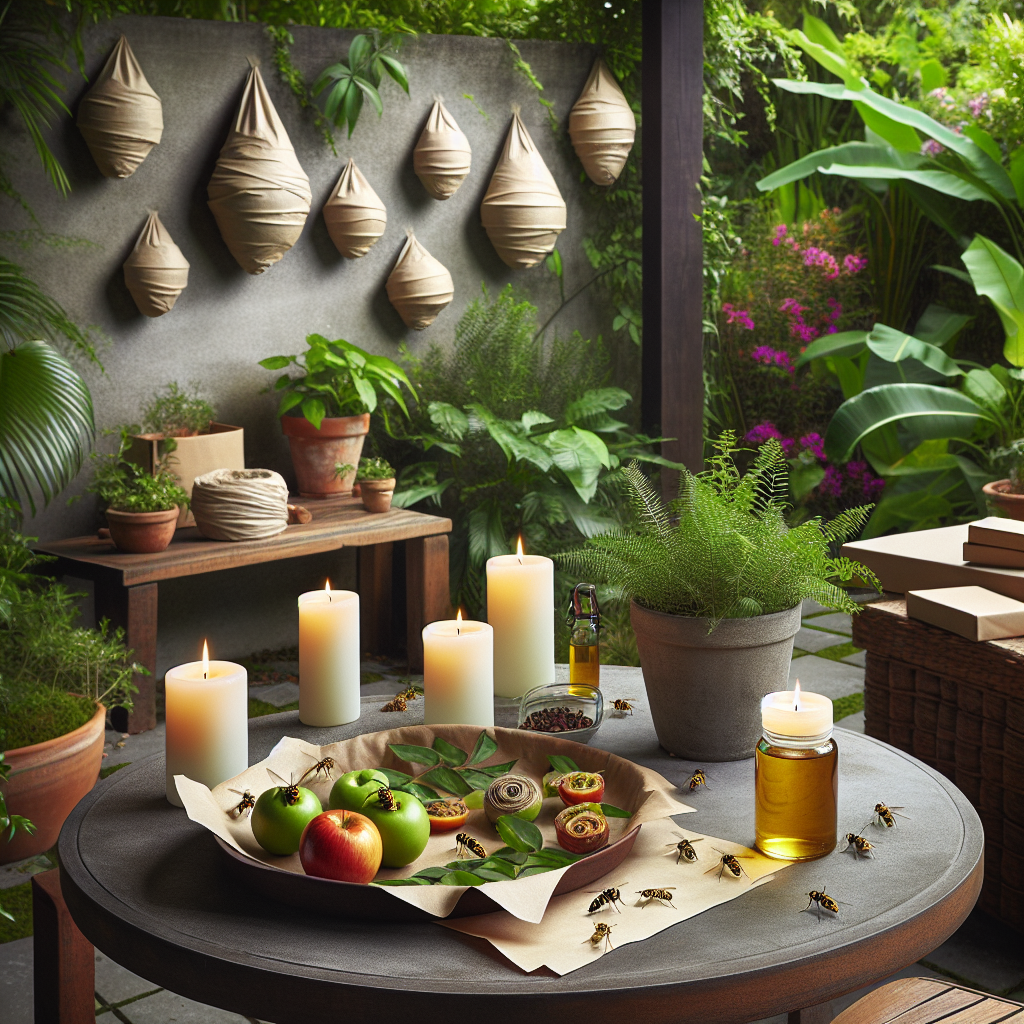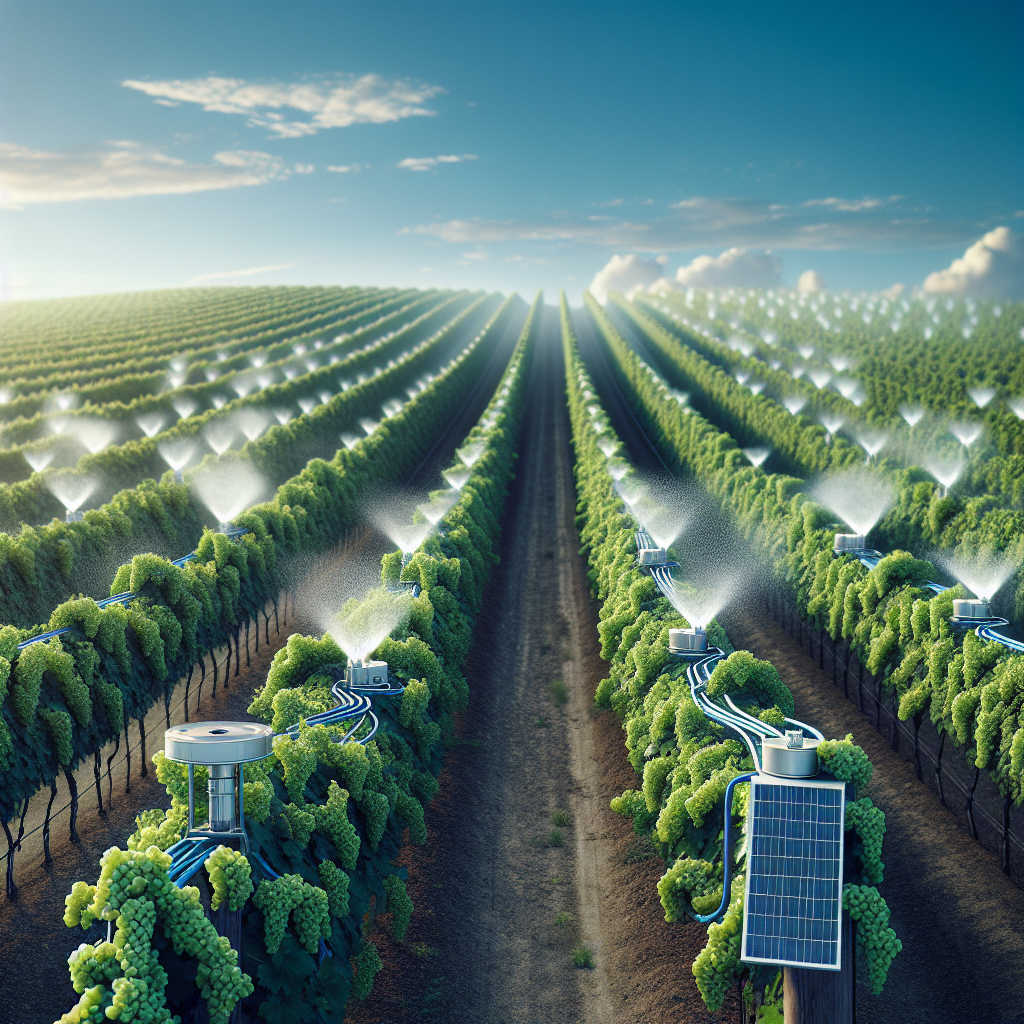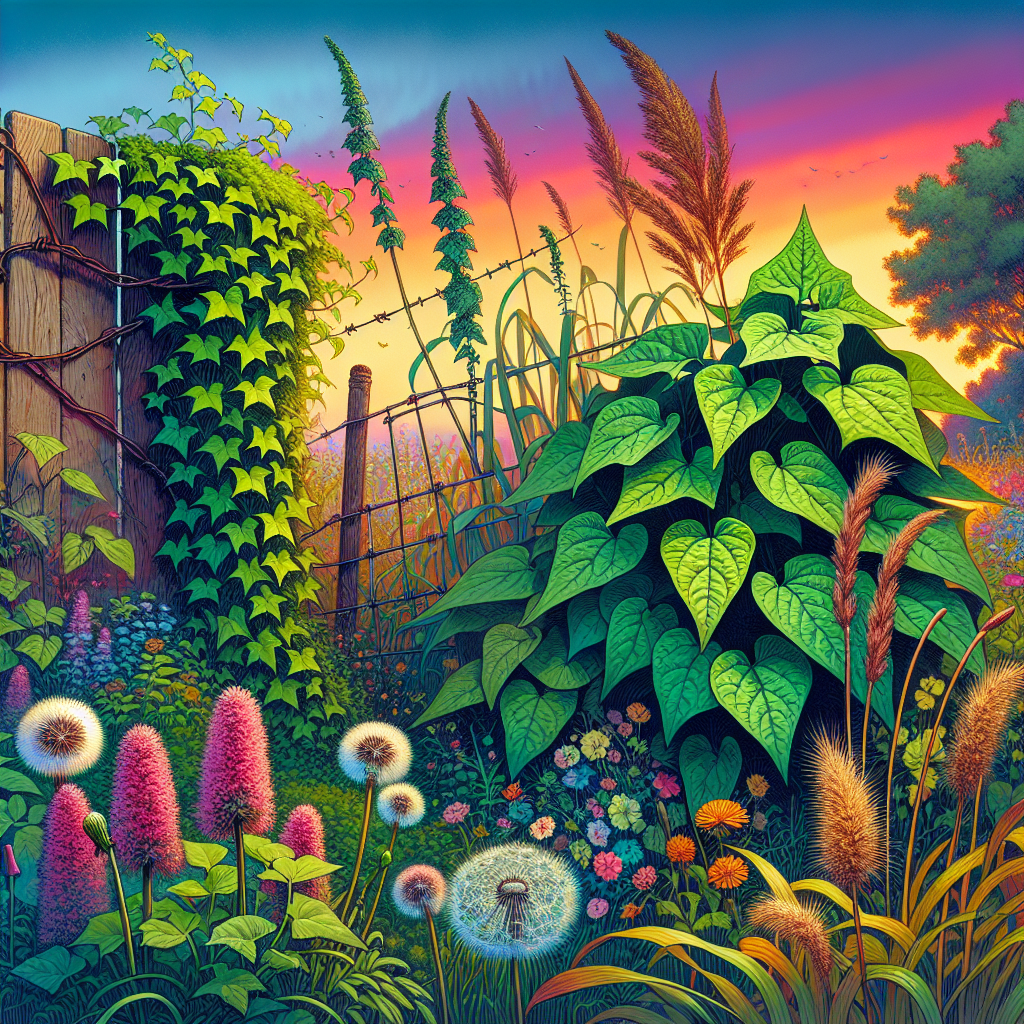How to Keep Wasps Away from Outdoor Areas
Updated July 17, 2024 at 7:18 am
Discover practical strategies and natural remedies to deter wasps and enjoy a peaceful outdoor space without the unwelcome buzzing guests.

Understanding Wasp Behavior to Prevent Encounters
Before delving into protective measures against wasps, let’s briefly touch on why wasps frequent outdoor areas. These insects are attracted by food, sweet scents, and places that provide potential nesting spots. Understanding their behavior is crucial in preventing encounters—after all, wasps usually don’t bother humans unless provoked or if they feel their nest is threatened.
Creating a no-attractant zone around your outdoor spaces can greatly reduce the chances of wasp infestations. This involves ensuring food is kept covered during picnics, trash lids are securely fastened, and sweet-smelling perfumes are used cautiously. By doing this, you’re removing the very things that tend to draw wasps in.
Natural and Chemical-Free Solutions
For those preferring a natural approach, there are several chemical-free methods you might want to consider. From planting wasp-repellent flora like peppermint and basil to using home-made decoy nests or essential oil mixtures, there’s a range of options that could keep these buzzing invaders at bay.
Moreover, DIY wasp traps using soda bottles and sugar water can be an effective way to catch wasps. It’s a simple project that requires minimal effort and provides a way to reduce wasp populations without harsh chemicals—an approach that aligns with environmentally friendly practices, like creating a pollinator-friendly garden.
Choosing the Right Wasp Repellants and Traps
When natural methods aren’t quite cutting it, or you’re looking for a more immediate solution, there are various commercial products to consider. Among these, Wasp Traps like the RESCUE Non-Toxic Wasp Trap are highly regarded for their effectiveness. This particular trap lures wasps with a scent attractant, trapping them inside where they eventually perish.
The user reviews for RESCUE traps often highlight how they significantly decrease the number of wasps in outdoor areas. Installing these traps around the perimeter of your yard can serve as a strong line of defense against these stinging insects.
Find This and More on Amazon
As for repellants, sprays like the Ortho Home Defense Hornet & Wasp Killer are often touted for their fast-acting formula and ability to tackle nests from a safe distance. The product claims to kill insects on contact and users report a high success rate in controlling local wasp populations.
Find This and More on Amazon
However, remember that these products should be used as directed to avoid harming beneficial insects or the environment. When using chemical repellents and traps, it’s also important to factor in the safety of pets and children who enjoy spending time in the yard.
Professional Wasp Removal Services
In cases where a wasp problem has escalated beyond DIY solutions, professional pest control services are your best bet. These experts have the training and equipment needed to remove nests safely and efficiently, minimizing the risk of stings or ongoing issues. Look for companies with strong customer reviews and eco-friendly practices for the best results.
Always exercise caution when dealing with wasps. If a nest is disturbed, these insects can become aggressive, posing a risk to you and those around you. Professional removal services not only solve your wasp problem but also ensure that the job is done safely, allowing you to enjoy your outdoor space without fear of being stung.
Preventive Maintenance to Sustain Wasp-Free Zones
To sustain a wasp-free zone, preventive maintenance is key. This involves periodic checks for nests around your property—especially in early spring when queens are looking to start new colonies. Sealing off potential entry points to your home and maintaining your garden are also important steps.
By regularly inspecting your property and tackling any warning signs early, you keep control over the situation and eliminate the need for more drastic measures in the future. Combine this with the continued use of non-attractive practices and natural repellants, and your chances of a wasp problem should be minimal.
Final Considerations
Balancing the need to control wasps while also promoting a healthy ecosystem is crucial. For example, wasps can be beneficial in managing other pest populations, as highlighted in harvesting tips for your vegetable garden. Therefore, focus on deterrence and preventive practices, rather than elimination, whenever possible.
Remember to also consider the impact on other wildlife. Birds, for instance, can be deterred by the same measures that discourage wasps, potentially affecting the biodiversity in your garden. Integrating bird feeders and bird baths on the opposite side of your property could help balance these effects. And if you’re also an indoor plant enthusiast dealing with low light conditions, applying insights from articles like “Mastering Pothos Plant Care in Low Light Areas” can help you create a harmonious environment inside and outside your home.
Integrating Physical Barriers and Landscaping Techniques
To complement natural and chemical solutions, you might also consider physical deterrents. For instance, installing fine mesh screens on windows and doors can prevent wasps from entering your home. Similarly, physically altering the landscape to make it less appealing to wasps is another strategy. This involves removing any old trees or logs where wasps could establish nests.
Landscaping with gravel or rock, rather than mulch, can also be effective since some wasp species prefer to nest in ground soil. Transferring to a rock garden not only adds aesthetic value to your property but also deters wasps from creating underground nests—a double win for you.
Understanding Your Local Wasp Species and Their Behaviors
Different regions are home to various types of wasps, each with unique behaviors and preferences. For instance, in some areas, the paper wasp is common, while in others, yellow jackets or hornets may prevail. By identifying the species prevalent in your area, you can tailor your approach to effectively keep them away from your living spaces.
If you’re unsure about the types of wasps in your locale, visiting a local extension office or consulting with pest control experts can provide you with the information you need. They can help you understand local species like the paper wasp, which prefers to build nests in sheltered areas and is less aggressive than its counterparts, thus requiring different management strategies.
Building a Wasp-Resistant Environment with Plants and Colors
Believe it or not, the colors and plants you choose for your garden can influence wasp behavior. Wasps are less attracted to certain colors, like shades of blue and white, so painting your deck or patio these colors might help ward them off. Additionally, strong-smelling plants such as eucalyptus, thyme, and geraniums have been suggested to naturally deter wasps due to their pungent scents.
While integrating wasp-repellent plants into your garden design, you should also avoid plants that attract them—typically those with bright flowers or sweet smells. This strategy not only reduces the allure for wasps but can also bring about a delightful change to your garden that attracts the right type of pollinators, such as bees and butterflies.
Regular Inspections and Timely Intervention
Once wasp season begins, it’s essential to perform regular inspections of your property for nests. Wasps tend to start building their nests in the spring, so early detection is crucial. Check under eaves, deck rails, and other sheltered spots where wasps are likely to build. If you find a small nest that has just been started, it’s generally safe to knock it down with a long pole.
However, this activity should be done at dusk or dawn when wasps are less active. With the timely intervention of potential nests, you’ll discourage wasps from settling in and convince them to move on to a different location—which is exactly what you want for a peaceful backyard experience.
Combining Efforts for a Comprehensive Strategy
Effectively managing a wasp problem often requires a multi-faceted approach. Combining physical barriers, wasp repellent plants, traps, and maintenance practices can offer the best protection. Remember, it’s not just about killing the wasps; it’s equally important to create conditions that are unfavorable for them to live and nest in the first place.
Together with the mentioned methods, proper gardening techniques and seasonal maintenance can deter wasps and allow you to reclaim your outdoor space. Consistency is key—by routinely checking and adapting your strategy, you can stay one step ahead of these stinging pests.
Emphasizing Safety and Deliberation in Wasp Control
It’s imperative to emphasize the importance of safety when dealing with wasps. The risk of allergic reactions to stings is a serious matter. Always take precautions like wearing protective clothing and avoiding perfumed body products that might attract wasps when you’re working or relaxing outdoors.
When handling wasp nests or choosing control methods, deliberate actions and well-thought-out plans are essential. Quick, ill-considered decisions can provoke an aggressive response from wasps, which can be dangerous. This considered approach to safety should also be applied when utilizing any plant or structural changes to your environment.
Nurturing a Harmonious Outdoor Ecosystem
Maintaining an outdoor space that’s welcoming to you but not to wasps is a balancing act. You want to enjoy your backyard without the constant threat of stings, but you also don’t want to harm beneficial insects or disrupt the local ecosystem. By focusing on prevention and natural deterrents, you support a healthier balance for all creatures.
Show consideration to the broader ecology by using a strategic approach to wasp control. This consideration extends to the way you care for your indoor plants, ensuring you’re not only deterring wasps but also providing a nurturing environment for your household plants to thrive, as discussed in “Caring for Snake Plants“.———-
Creating a Year-Round Plan to Minimize Wasp Presence
Adopting a year-round strategy is essential for keeping wasps at bay. This includes being proactive during the off-season; wasps are less active in colder months, which is the ideal time to fortify your home and garden. Seal potential entry points where wasps might enter to build their nests when it warms up, and consider implementing house and garden maintenance routines to deter wasp activity.
For instance, keeping gardens free of fallen fruits and regularly emptying and cleaning trash bins can go a long way in making your outdoor space less enticing to wasps. Engaging in these activities throughout the year can greatly reduce the likelihood of an unwelcome wasp population come spring and summer.
Providing Alternatives to Attract Wasps Elsewhere
In some cases, diverting wasps to alternative locations away from your home can be an effective strategy. This can be achieved by setting up wasp feeders filled with sugar water at the far end of your property. While it may seem counterintuitive to attract wasps, the idea is to offer them a source of food away from areas where people congregate, so they’re less likely to be a nuisance.
It’s important to monitor these feeders to ensure they’re not attracting too large a number of wasps, which could inadvertently create a bigger problem. If you notice the wasp numbers increasing, it might be worth removing the feeders and reconsidering your approach.
Exploring Technological Innovations in Wasp Control
Technology is continually advancing, and this includes innovations in pest control. Ultrasonic repellents, for example, emit frequencies that are unpleasant to wasps but inaudible to humans. While opinions on their effectiveness vary, some users swear by their ability to keep wasps away without using chemicals or traps.
If you’re interested in a technological solution, it might be worth exploring options like the BRISON Ultrasonic Pest Repeller. This device has garnered positive feedback for being discreet and easy to use, with some reviews indicating a noticeable decrease in the presence of wasps and other pests.
Find This and More on Amazon
Be mindful, though, that ultrasonic devices should not be seen as a standalone solution but rather as a complementary tactic as part of a broader wasp control strategy.
Understanding Legal Considerations and Wildlife Protection
Finally, it’s crucial to be aware of any legal considerations surrounding wasp control in your area. Some wasp species may be protected, especially if they’re considered beneficial for the environment. Before taking any drastic measures, check with local wildlife agencies to ensure you’re in compliance with regional laws and guidelines.
Respect for wildlife is also a moral obligation. As part of a responsible approach, even when dealing with pests, consider the role these creatures play in the larger ecosystem. This respect is echoed in practices for maintaining household plants in low light, as it requires understanding and working with the natural behavior of each species, as observed in articles related to peace lily care in low-light conditions.
Summary of Strategies to Keep Wasps at a Distance
To recap, there’s a multitude of strategies you can employ to keep wasps away from your outdoor areas. Whether you choose to focus on preventive measures, opt for natural repellents, explore technological innovations, or use wasp traps and chemical repellents with due consideration, remember that a combined and consistent approach is often the most effective.
By maintaining your property, staying vigilant for signs of wasps, and undertaking the necessary steps at the right time, you can enjoy your outdoor spaces with minimal interference from these flying insects. With patience and diligence, your home and garden can be a safe and enjoyable sanctuary for you, your family, and your guests.
Shop more on Amazon
Flowers & Plants Team
Flowers & Plants Team



